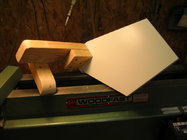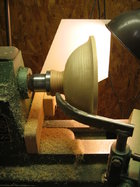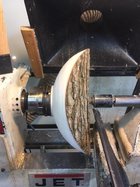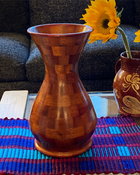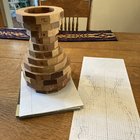odie
TOTW Team
- Joined
- Dec 22, 2006
- Messages
- 7,116
- Likes
- 9,828
It is my opinion that many people, whether artistically inclined or not, are aesthetically inspired by a perfect curve as contained within turned bowls. In other words, perfect curves, whether ogee, or simple curves resonate within the senses of quite a few people.....and, this observation is mainly at a subconscious level. Of course this innate ability culminates in an "approval".....or not necessarily a disapproval, but not being able to capture attention, therefore passing it by.
We, as bowl turners, don't have a lot of free exercise of creativity.....that is, if the goal is to produce a lathe turned bowl that stands alone without embellishments.....a bowl that is completely crafted the old fashioned way of exclusively turning it on our lathe. We must concentrate on perfecting small elements, and the creativity comes with combining those small elements into an overall pleasing shape.
We must fine tune our senses of "seeing" the perfect curve, and that simple act isn't as simple, or achievable, as some think. Most of us have seen bowls with imperfect curves. We might not say so, because the turner is unaware of how the curve he has achieved isn't seen the same way by others, as he himself sees it. IOW, thinks he's closer to perfection, when it's obviously not, by others. It's important to note that I'm not necessarily speaking of other turners exclusively.....but, the all important casual observer. Those of us who aspire to sell our bowls, need to comprehend the implications of this one little aspect, or we'll be forever not appreciated.....and, will probably never figure out why that is. The more complex the overall shape, the more importance each and every small curve within it must conform, and contribute to the total shape.
Note that aggressive sanding alters the perfect curve.
-----odie-----
We, as bowl turners, don't have a lot of free exercise of creativity.....that is, if the goal is to produce a lathe turned bowl that stands alone without embellishments.....a bowl that is completely crafted the old fashioned way of exclusively turning it on our lathe. We must concentrate on perfecting small elements, and the creativity comes with combining those small elements into an overall pleasing shape.
We must fine tune our senses of "seeing" the perfect curve, and that simple act isn't as simple, or achievable, as some think. Most of us have seen bowls with imperfect curves. We might not say so, because the turner is unaware of how the curve he has achieved isn't seen the same way by others, as he himself sees it. IOW, thinks he's closer to perfection, when it's obviously not, by others. It's important to note that I'm not necessarily speaking of other turners exclusively.....but, the all important casual observer. Those of us who aspire to sell our bowls, need to comprehend the implications of this one little aspect, or we'll be forever not appreciated.....and, will probably never figure out why that is. The more complex the overall shape, the more importance each and every small curve within it must conform, and contribute to the total shape.
Note that aggressive sanding alters the perfect curve.
-----odie-----
Last edited:

